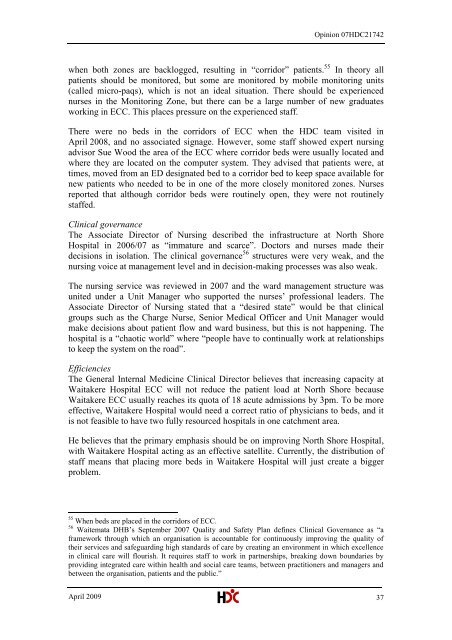North Shore Hospital report - New Zealand Doctor
North Shore Hospital report - New Zealand Doctor
North Shore Hospital report - New Zealand Doctor
Create successful ePaper yourself
Turn your PDF publications into a flip-book with our unique Google optimized e-Paper software.
Opinion 07HDC21742when both zones are backlogged, resulting in ―corridor‖ patients. 55 In theory allpatients should be monitored, but some are monitored by mobile monitoring units(called micro-paqs), which is not an ideal situation. There should be experiencednurses in the Monitoring Zone, but there can be a large number of new graduatesworking in ECC. This places pressure on the experienced staff.There were no beds in the corridors of ECC when the HDC team visited inApril 2008, and no associated signage. However, some staff showed expert nursingadvisor Sue Wood the area of the ECC where corridor beds were usually located andwhere they are located on the computer system. They advised that patients were, attimes, moved from an ED designated bed to a corridor bed to keep space available fornew patients who needed to be in one of the more closely monitored zones. Nurses<strong>report</strong>ed that although corridor beds were routinely open, they were not routinelystaffed.Clinical governanceThe Associate Director of Nursing described the infrastructure at <strong>North</strong> <strong>Shore</strong><strong>Hospital</strong> in 2006/07 as ―immature and scarce‖. <strong>Doctor</strong>s and nurses made theirdecisions in isolation. The clinical governance 56 structures were very weak, and thenursing voice at management level and in decision-making processes was also weak.The nursing service was reviewed in 2007 and the ward management structure wasunited under a Unit Manager who supported the nurses‘ professional leaders. TheAssociate Director of Nursing stated that a ―desired state‖ would be that clinicalgroups such as the Charge Nurse, Senior Medical Officer and Unit Manager wouldmake decisions about patient flow and ward business, but this is not happening. Thehospital is a ―chaotic world‖ where ―people have to continually work at relationshipsto keep the system on the road‖.EfficienciesThe General Internal Medicine Clinical Director believes that increasing capacity atWaitakere <strong>Hospital</strong> ECC will not reduce the patient load at <strong>North</strong> <strong>Shore</strong> becauseWaitakere ECC usually reaches its quota of 18 acute admissions by 3pm. To be moreeffective, Waitakere <strong>Hospital</strong> would need a correct ratio of physicians to beds, and itis not feasible to have two fully resourced hospitals in one catchment area.He believes that the primary emphasis should be on improving <strong>North</strong> <strong>Shore</strong> <strong>Hospital</strong>,with Waitakere <strong>Hospital</strong> acting as an effective satellite. Currently, the distribution ofstaff means that placing more beds in Waitakere <strong>Hospital</strong> will just create a biggerproblem.55 When beds are placed in the corridors of ECC.56 Waitemata DHB‘s September 2007 Quality and Safety Plan defines Clinical Governance as ―aframework through which an organisation is accountable for continuously improving the quality oftheir services and safeguarding high standards of care by creating an environment in which excellencein clinical care will flourish. It requires staff to work in partnerships, breaking down boundaries byproviding integrated care within health and social care teams, between practitioners and managers andbetween the organisation, patients and the public.‖April 2009 37
















